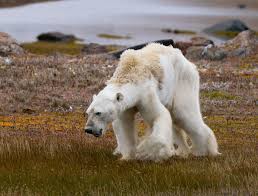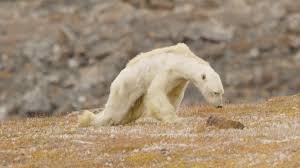About two years ago, while scrolling on Instagram, I came across an image of a skinny polar bear. At first, I thought that the image was either fake or photoshopped, but once I looked it up and found out that it was real, I became speechless. I had never seen an animal that looked that fragile and weak before. Once I found out that the image was real, I did some research and found the photographer and the website that it had originally been published in, National Geographic. The article stated that the image was intended on raising awareness for climate change by showing the detrimental effects that it has had on animals around the world, including polar bears. This was one of the first times that I can remember when I realized the severity of climate change because prior to this, my knowledge of this issue had simply been from articles or from my parents.


After seeing how one image reached over millions of people around the world, this made me understand how vital photography can be in raising awareness of the grim climate situation to people who cannot see the destruction for themselves. Photography is a very effective way to raise awareness on the severity of climate change because images are not only a universal language that can be understood by people from all parts of the world, but also because their transparency provides the audience with a piece of evidence that cannot be disputed or claimed as false since it was taken from a real-life event. Climate change photography has definitely had a significant impact on how I view the Anthropocene and our current climate situation because it has allowed me to form personal connections with the animals that have been affected. As a result of this personal connection, I have become more aware of the damages that climate change has on these innocent creatures than I was before.
https://www.nationalgeographic.com/news/2017/12/starving-polar-bear-video-climate-change-spd/

Mainly when the public thinks of climate change, they think of the impact it is going to have on humans not necessarily the impact it will have on animals (like the polar bear). The topic of the blog is different, and I was devastated to see the skinny, cold polar bears out in the wild. To me, the blog seemed to have more pathos, but there could also be an incorporation of logos. How does photography allow you to form a personal connection with animals? How has climate change had “an impact on how you view the Anthropocene”? Be specific.
Gloria, I like the question you posed—how does photography allow you to form a personal connection with animals? Very thought provoking.
After reading your article, I couldn’t agree with you more. Photography really has a lot of power, and through its spread it can make people feel the seriousness of a problem. Because the energy that vision delivers to people tends to be more intense. When we see a picture of a polar bear, our first reaction must be why is it different from our image of a polar bear? Which leads us to think, why is this happening? What can we humans do to change this? The world really needs environmental photographers, and thank them for letting us know more about this huge world.
Serene, I’m thinking about diction in your reply—”Because the energy that vision delivers to people.” Well put, seeing a polar bear in person is a completely different experience/reality from seeing it as a photo. If photos make us feel more sympathy as opposed to fear, are we more able to dispose of it also and put it on the back of our minds?
Peyman, I love this article because it perfectly captures how imagery can profoundly impact the way we see the world and examine our previous assumptions. I had no idea that Polar Bears can be driven to the state that we’re looking at in this post. The sharp contrast between our perception of what life looks like for animals around the globe and the reality of their experiences with the climate crisis; needs to drive us to act. I hope that National Geographic is successful in using its imagery to spur environmentalist action. The logos and pathos you used to communicate the urgency of these issues fill me with hope that it is possible.
Kamran, is there an ideal image of polar bears that these images are undermining? If so, you’re raising an interesting point about how photography can give a call to action by creating a sense of paradox.
I believe the power of photography is extremely strong and can impact people from around the world. I agree with your statements about how photography can raise awareness on climate change. Whenever I see something that seems interesting or abnormal, the first thing I feel is curiosity. I always wondered about “how did this happen or how did that happen”? With your picture of the polar bear, I am thinking that the polar bear looks so different from other polar bears and want to know how it came to be. Sight is one of our human senses and by using it we can see the truth.
Alan, I like the insight that photography can be a source of logos.
I really liked the way that you portrayed the problem in this article. Although the pictures are very hard to look at, it is a great way to get people to really realize the problem and understand what is wrong. People think that climate changed only affects humans, but there is also a big impact that it has on animals as well. I hope that the more people who see this and the more that the environmental websites spread this picture, the more environmentalist action will be taken. The world needs for photographers that capture these types of images and not only the good in the world.
Sadie, we’re definitely losing a lot of animals with climate change—its sad to think that a lot of animals we take for granted now might become as mythical as unicorns years down the line.
I really liked how you took it upon yourself to look into why they posted that picture and told us why it caught your eye. I agree with you that pictures and visuals are a great way to get people’s attention. I also liked how you found this information by going on Instagram and how social media is trying to get it’s audience’s attention in a simple way like that.
Kaitlyn, Instagram and social media is definitely a powerful way to raise awareness—I’m also thinking abut the Save the Turtles campaign.
I saw this picture the other day. It is unimaginable that far away from us, there are a great number of animals suffering because of human behavior. And most of the time it’s hard to see our impact in time. The image is visually striking. In fact, we do not think of the time, some people are doing what they can to warn us, face these may have been irreparable mistakes. I think it’s sad in a way.
Laura, we really might be past the point of no return for the polar bears.
I really liked that you opened your blog post with an event I assume everyone in the class can relate to. Instagram is a very common platform that people to check multiple times a day and images like the ones you provided in the post were circulating Instagram often and for a long period of time. I also liked that you included images because it allows the audience to understand what you are describing better and provides a more emotional response from the reader. It was an interesting post and I am planning on researching more about the polar bears.
The venue really matters! Instagram has a really powerful audience group too, more so than Facebook (which has gotten less cool and hence, less impactful over the past few years).
I love this blog very much! Years ago, I also see the same picture as you post. But at that time, I know the climate change is happening all the time. Not only the skinny polar bear, but also the starved penguins. All the animals are suffer hardships because of the climate change. Climate not only change the human, but also animals. People need to consider about animals, because there will be more disasters when food chain break.
Good connection between the bears and penguins, Ruize—our impact on the Poles and their inhabitants is catastrophic. And bound to get more so, especially since oil has been discovered on the North Pole, if I’m not mistaken?
Hey Peyman, I really like how you combine the power of photography and the power of social media to inspire an individualized response for masses of people. I also like how you bring up the Anthropocene. Being able to show the pains of climate change far away from home to people across the nation. Very awesome!
Good analysis, Zoe—that social media has a huge power to make change by creating “an individualized response for masses of people.” Well put.
Well done on the blog, Peyman—you’ve mentioned your fascination with wildlife photography before, and this post taps into to your interests. I really like the way you are analyzing photographs here, its very rhetorical. Love this sentence especially: “images are not only a universal language that can be understood by people from all parts of the world, but also because their transparency provides the audience with a piece of evidence that cannot be disputed or claimed as false since it was taken from a real-life event.” Images do indeed have a logic, and their claim to bring us closer to reality is the most powerful aspect about their magic.